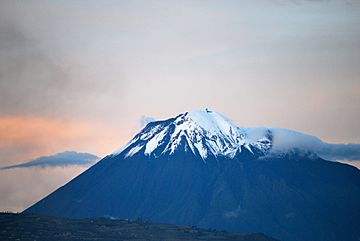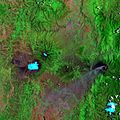Tungurahua facts for kids
Quick facts for kids Tungurahua |
|
|---|---|

View from Riobamba (September 2011)
|
|
| Highest point | |
| Elevation | 5,023 m (16,480 ft) |
| Prominence | 1,554 m (5,098 ft) |
| Listing | Ultra |
| Naming | |
| English translation | Throat of fire |
| Language of name | Quechua |
| Geography | |
| Location | Ecuador |
| Parent range | Cordillera Oriental, Andes |
| Topo map | IGM, CT-ÑIV-D1 |
| Geology | |
| Age of rock | Holocene (Gomez 1994) |
| Mountain type | Stratovolcano (active) |
| Volcanic arc/belt | Northern Volcanic Zone |
| Last eruption | 2000 to 2018 (ongoing) |
| Climbing | |
| First ascent | 1873 by Alphons Stübel and Wilhelm Reiss |
| Easiest route | Scrambling/Snow/Ice PD |
Tungurahua is a tall, active volcano in Ecuador. Its name comes from the Quechua words tunguri (throat) and rahua (fire). So, Tungurahua means "Throat of Fire." It is a stratovolcano, which means it's a cone-shaped volcano built up by many layers of hardened lava, ash, and rocks.
This volcano is part of the Cordillera Oriental mountain range in the Andes. The area around the volcano is even named after it, called Tungurahua Province.
Volcano Activity
Tungurahua is an active volcano. This means it can erupt. Its activity started again on August 19, 1999. Since then, it has had many big eruptions. The last major eruption began on February 1, 2014. The volcano has been active on and off since 2000.
Images for kids
-
False-color satellite image of Tungurahua (center right, with plume of ash emanating from it) and its neighbor Chimborazo
See also
 In Spanish: Volcán Tungurahua para niños
In Spanish: Volcán Tungurahua para niños


